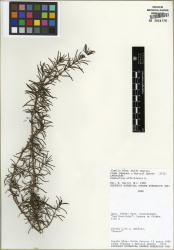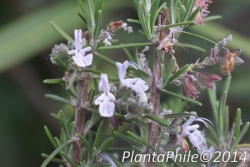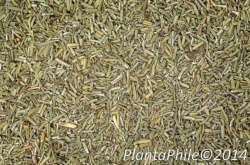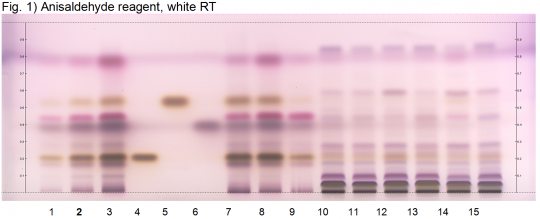Rosmarinus officinalis (aerial parts)
m |
(add PlantaPhile references) |
||
| (2 intermediate revisions by one user not shown) | |||
| Line 1: | Line 1: | ||
| − | {{DISPLAYTITLE:''Rosmarinus officinalis'' (aerial parts) }} | + | {{DISPLAYTITLE:''Rosmarinus officinalis'' (aerial parts) }} {{askbox|herb=''Rosmarinus officinalis''}} |
=Nomenclature= | =Nomenclature= | ||
| Line 25: | Line 25: | ||
=Organoleptic Characteristics= | =Organoleptic Characteristics= | ||
| + | {| border=1 | ||
| + | | | ||
| + | {{Organolepsy | source=United States Dispensatory (1918) | ||
| + | | description=[''Rosmarinus officinalis'''] leaves ... have a strong balsamic odor, which is possessed, but in a less degree, by all parts of the plant. Their taste is bitter and camphorous. | ||
| + | The tops lose a portion of their sensible properties by drying, and become inodorous by age. }} | ||
| + | |} | ||
=Macroscopic Characteristics= | =Macroscopic Characteristics= | ||
| + | {| border=1 | ||
| + | | | ||
| + | {{Macroscopy | source=United States Dispensatory (1918) | ||
| + | | description=Rosemary is a small evergreen shrub, with an erect stem, divided into many long, slender, ash-colored branches. The leaves are numerous, sessile, opposite, about 2.5 cm. long, rigid, linear, entire, obtuse at the summit, folded backward at the edges, of a firm consistence, smooth and green on the upper surface, whitish, woolly, and glandular beneath. The flowers are axillary, pale blue or white.}} | ||
| + | {{ Media2 | cat=Macroscopy | ||
| + | | source=PlantaPhile | ||
| + | | mainimage=PlantaPhile - 1997.jpg | ||
| + | | companyimage=PlantaPhile logo.jpg | ||
| + | | companyURL=http://plantaphile.com/ | ||
| + | |||
| + | | source2=PlantaPhile | ||
| + | | image2=PlantaPhile - 2567.jpg | ||
| + | | companyimage2=PlantaPhile logo.jpg | ||
| + | | companyURL2=http://plantaphile.com/ | ||
| + | | }} | ||
| + | |} | ||
| + | |||
=Microscopic Characteristics= | =Microscopic Characteristics= | ||
Latest revision as of 18:30, 28 April 2015
Contents |
Nomenclature
Rosmarinus officinalis L. Lamiaceae
Standardized common name (English): rosemary
Botanical Voucher Specimen
|
|
Organoleptic Characteristics
|
Macroscopic Characteristics
|
Microscopic Characteristics
High Performance Thin Layer Chromatographic Identification
|
Rosemary oil (aerial parts) (Rosmarinus officinalis) Lane Assignments Lanes, from left to right (Track, Volume, Sample):
Reference Sample(s) Reference: Individually dissolve 1 mg of borneol and 1 mg of bornyl acetate in 1 mL of methanol. Optional: Dissolve 10 µL of cineole in 1 mL of methanol. Stationary Phase Stationary phase, i.e. Silica gel 60, F254 Mobile Phase Ethyl acetate, toluene 5:95 (v/v) Sample Preparation Method Sample: Dissolve 20 µL of essential oil in 1 mL of toluene. Optional: mix 0.5 g of powdered dry Rosemary leaf with 5 mL of toluene and sonicate for 10 min, then centrifuge or filter the solutions and use the supernatants/filtrates as test solution. Derivatization reagent: Anisaldehyde reagent, Preparation: 170 mL of ice-cooled methanol are mixed with 20 mL of acetic acid, 10 mL of sulfuric acid and 1 mL of anisaldehyde, Use: Dip (time 0, speed 5), heat at 100°C for 5 min. Detection Method Saturated chamber; developing distance 70 mm from lower edge; relative humidity 33% Other Notes Images presented in this entry are examples and are not intended to be used as basis for setting specifications for quality control purposes. System suitability test: Borneol: brownish zone at ~ 0.21; Bornyl acetate: brown zone at ~ 0.54. Identification: Compare result with reference images. The fingerprint of the test solution is similar to that of the corresponding botanical reference sample. Additional weak zones may be present. The chromatogram of the test solution shows a purple zone in the upper third. At the position of reference bornyl acetate there is a yellowish brown zone. Below this zone a purple zone is detected. At the position of reference cineole there is a greyish violet zone. At the position of reference borneol a yellowish brown zone is seen, just above and below this zone there is each a greyish violet zone.
|
Supplementary Information
Sources
- ↑ MOBOT, Tropicos.org http://www.tropicos.org/Image/100002347
- ↑ United States Dispensatory (1918)
- ↑ United States Dispensatory (1918)
- ↑ PlantaPhile http://plantaphile.com/
- ↑ PlantaPhile http://plantaphile.com/
- ↑ HPTLC Association http://www.hptlc-association.org/



